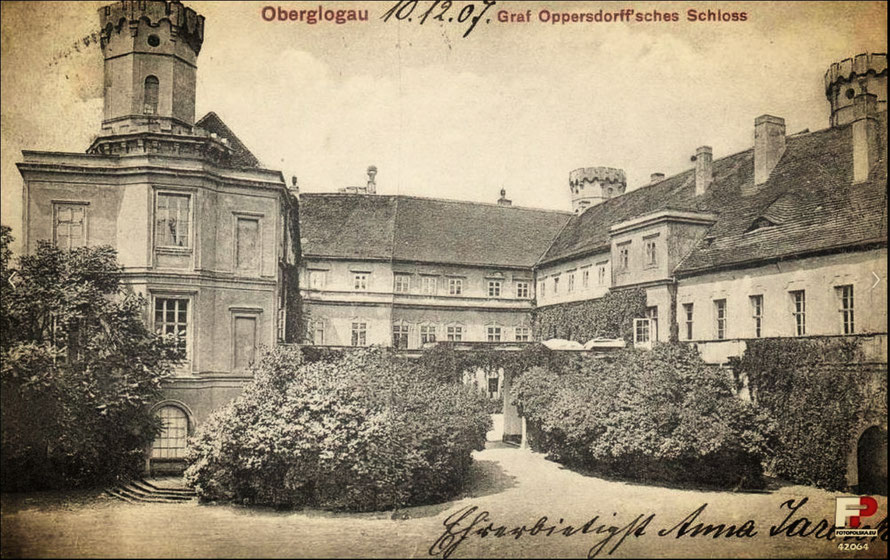The Counts of Oppersdorff - History Milestones
1272 First Mention
The family can be traced back to the ancient Meißen lineage of the von Rolle. The first mention of the name Thidericus miles dictus
Rolle appears in a document dated 19th May 1272.
1321 in Silesia
The first recorded evidence of the family’s presence in Silesia dates back to 1321 and 1325 with the names Rullo, or Henko Rullonis.
Henko serves as nobleman to Albrecht the Younger, Duke of Opole.

1363 Primogenitor
The uninterrupted family lineage begins with Henricus de Oprechtsdorf, whose name first appears in certificates in 1363.
1432 Haidau Estate
His son, Hans Rolle von Ulprichsdorf (*1388; †1445) marries Anna Posadowsky von Postelwitz. With this liaison, the Haidau estate near Strzegom
(Striegau), inherited from her mother Helene von Dyhrn, becomes family property. Their grandson Friedrich von Oppersdorff (* 1471; † 1544), captain of Brieg-Ohlau, is known as the
Black Cavalier (Schwarzer Reiter).
1554 Elevation to the Rank of Baron
His three sons, Hans, Wilhelm I and Georg I, receive the Lower Austrian title of Baron in 1552 from the
Habsburg Emperor, and two years later the hereditary Austrian rank of Baron. Hans, who distinguished himself during the Turkish wars, is awarded the Bohemian estates of Aich and
Friedstein as fiefdoms by the Habsburg monarchy.
1562 Acquisition of Oberglogau
In 1562 Hans acquires the dominion Oberglogau (Głogówek). He commences the castle’s reconstruction. This also marks the beginning of
an uninterrupted, almost 400 year-long interconnectedness of the family with the city of Oberglogau. The property passes on to his brother Georg I (*1516; †1577), already in
possession of Polnisch-Neukirch.
1626 Elevation to the Rank of Count
Georg III (*1588; †1651), imperial chamberlain and councillor, governor of Greater Glogau and councillor to the King of
Poland, is raised to the rank of Imperial Count on 22nd June 1626 in Vienna, with the title of «Noble Highness», and an improvement of the coat-of-arms. His brother Friedrich is awarded
the same title in 1635.
1642 Family Estate Foundation
It is the same Georg III (*1588; †1651) who renovates the castle in grandiose Baroque style. As a major patron of the arts and
founder the court’s printing house, he establishes the hereditary family Estate on 16th February 1642 and institutes himself as its first Lord.
1655 Refuge of the King of Poland
From 17th October to 18th December 1655 the Polish King Jan Kazimierz Wasa, with his consort Maria Ludovika Gonzaga and their court, is
granted refuge from the armies of the Swedish King Charles X in castle of the Count von Oppersdorff at Oberglogau.
1806 Beethoven in Oberglogau
Franz von Oppersdorff (*1778; †1818) is a friend and supporter of Ludwig van Beethoven, who resides at the castle in Oberglogau
in 1806, where he works on the composition of his 4th and 5th symphonies, dedicating the 4th to the Count.
1889-1930 Johann Baptist Hans Georg
Hans von Oppersdorff (*1866; †1948) takes over the estate of Oberglogau with its 16,000 acres from his grandfather
Eduard in 1889. He is member of the Prussian House of Lords, and parliamentarian from 1907 to 1918 in Berlin. In 1930 he concedes the Estate to his first-born son and dislocates with his
wife Dorothea Princess von Radziwiłł to France, where he dies in Lourdes in 1948.

1930-1945 Last Estate and Flight
Wilhelm Karl Hans (Halla) (*1896; †1989) becomes Estate Lord in 1930 following his father’s renouncement. Upon the Estate's
dissolution in 1935 he manages the family’s dominion in Oberglogau. He marries Marie Louise Princess von Isenburg. By the end of World War II in 1945, the family flees the castle, evading
the approaching Russian army.
2017 Family Gathering
72 years later, from 1st to 4th September 2017, a good 60 family members from Germany, France, Belgium, England, Poland, the Czech Republic,
Switzerland and the United States gather for a historic reunion at the family’s former seat in Oberglogau, Upper Silesia.
Sources
Genealogisches Handbuch des Adels, C.A. Starke Verlag, Limburg an der Lahn, 1991
Wilhelm Hans Graf von
Oppersdorff: Chronik, Status, Wappen und Devise der Grafen von Oppersdorff, Frankfurt a.M. 1963
Wikipedia entry in German for «Oppersdorff (Adelsgeschlecht)»



